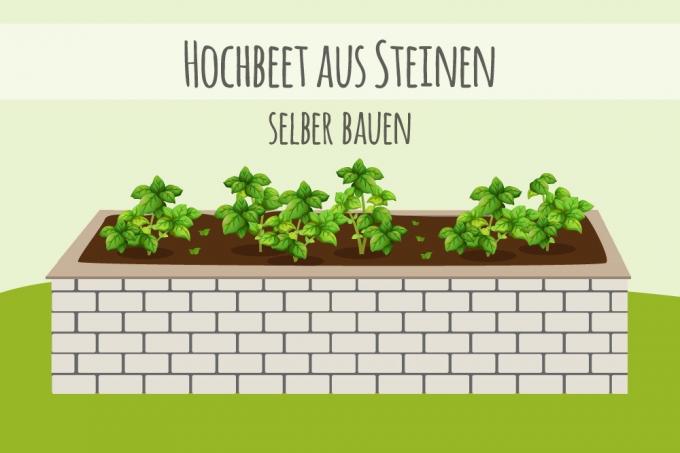
table of contents
- Raised bed made of stones
- Tools and material
- foundation
- Material requirements
- Implement the foundation
- Wall raised bed made of stones: Instructions
- 1. Mix the mortar
- 2. Place the first stone layer
- 3. Align stones
- 4. Fix the stone layer
- 5. Layer stones
- 6. Disguise
- 7. Pond liner as moisture protection
- 8. Fill the raised bed
A raised bed is ideal for numerous gardens, properties and terraces and provides an opportunity for growing vegetables, flowers and other plants in urban areas. Raised beds made of stones are very popular because of their durability, even if they have to sacrifice their mobility for it. If you want to build a raised stone bed on your own, you need the right types of stone, tools and detailed instructions for implementing the project.
Raised bed made of stones
Tools and material
Before you can start building the raised bed, you need the appropriate materials, tools and, above all, the stones. They are the most important thing for the construction of a wall, because they must have certain properties, especially for use as a raised bed, in order to be able to withstand numerous external influences. The following types of stone have proven to be particularly effective, many of which are popular natural stones which, thanks to their decorative character, can be integrated into numerous garden projects permit:
- granite
- basalt
- Sandstone
- dolomite
- crystalline marble
- Field stones
- Bricks
- Concrete bricks
- clinker
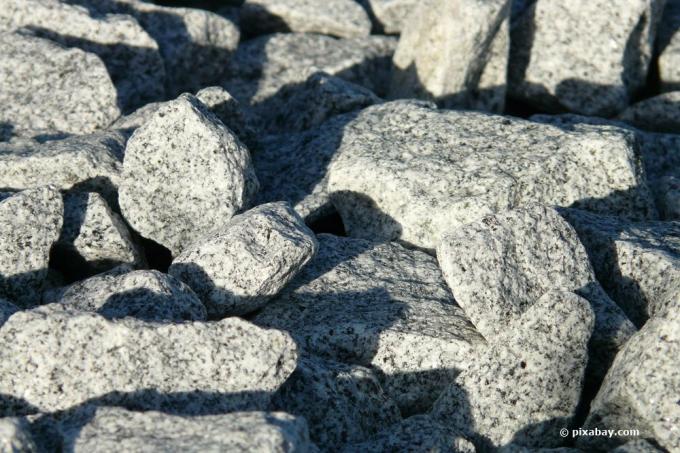
The design options differ depending on the type of stone. In most cases, natural stones have irregular edges and can therefore not be built with absolute precision. For this, these types of stone are well adapted to the local weather conditions. In addition, even after careful construction, they still offer small loopholes for numerous animals that can use the bed as a shelter.
Bricks, clinker and bricks made of concrete, on the other hand, are for the dimensionally accurate Wall construction usable. If you use field stones, you need more mortar, but the raised bed looks particularly rustic, natural or even romantic.
In addition to the matching stones, you will also need the following materials and tools:
- Mortar for mixing
- Trowel
- Rabbit wire or other grids as protection against rodents and vermin
- Pond liner
Calculate the need for stones based on the size of the bed. Brick or concrete bricks can be calculated without any problems due to their clearly defined dimensions. Natural stones, especially field stones, are difficult to measure accurately. Here you need to estimate and order more as a precaution. The pond liner protects the bricks from moisture.
tip: The use of a stone wall in dry construction is also possible for raised beds, but not really recommended, as the stones are only stacked and fixed from the inside or outside over the earth will. This makes it difficult to change the substrate, as the walls of the bed are not as solid as in a bricked-up specimen.
foundation
Another important part of the raised bed made from the above-mentioned types of stone is the foundation. Without a foundation, there will be shifts that have a negative impact on the stability and structure of the raised bed and can even damage the material in the long term. Therefore, you need to prepare the floor appropriately so that it can withstand the weight. The big advantage: You don't have to pour concrete foundations for a raised bed. Submit here Gravel foundation completely saving you work, time and money. The material and tools required as follows:
- Gravel (grain size 16 - 32 mm up to a maximum of 45)
- Plate compactor
- long nails
- sturdy cord
- shovel
- Folding rule or tape measure
- Spirit level
Since a raised bed has only a small height and therefore the amount of stones used remains small, there is often no great burden on the ground and the foundation. So it is completely sufficient if this has an average depth of 20 centimeters. You can choose the type of gravel used, but since you cannot actually see the bed foundation, you can easily go for inexpensive variants.
Material requirements
Material requirements are calculated using the following formula:
Length in m x width in m x height in m x bulk weight in kg / m³ = material requirements in kg
If you have a raised bed one meter long and two meters wide and Carrara marble gravel in it If you are using a grain size of 15-25 millimeters (1,500 kilograms per cubic meter), you will need the following for the raised bed foundation to calculate:

This gives you a requirement of 600 kilograms for the raised bed foundation. That sounds like a lot at first glance, but you have to note that this has to carry a lot of soil and plants without shifting. Due to the use of the vibratory plate, volume is also lost as the raised bed foundation is compacted.
Implement the foundation
Once you have the gravel and vibratory plate available, do the following to move the raised bed foundation:
1. After you have selected a suitable, preferably level, location for the raised bed foundation, start staking out the dimensions. For this you need the long nails and the cord with which you can easily mark the outline for the raised bed made of stones within a short time.
2. Once the bed has been marked out, start with an excavation of 20 centimeters. If you can involve family members or friends in this work, it goes much faster. In particular, make sure that the walls of the excavation do not protrude too far into the hole. A right angle would be ideal. Compact the soil with the plate compactor.
3. Now fill the hole with a layer of gravel and compact the stones with the vibrating plate. Repeat this process until the entire hole has been filled in this way.
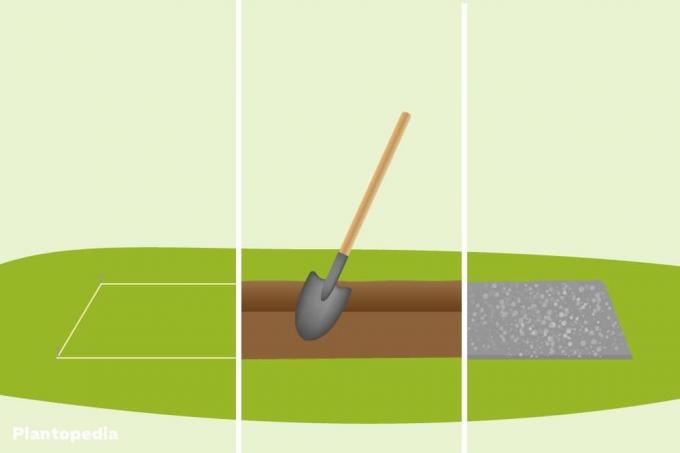
The foundation is now complete. This base is ideal for building your bed from stones. Even with very large raised beds, which are used, for example, to fasten slopes, a cast concrete foundation is worthwhile instead, as these offer more stability over the long term. For a simple raised bed, on the other hand, the gravel variant is completely sufficient.
tip: If you don't have a plate compactor yourself or if you want to buy one, you can borrow one from hardware stores and specialist dealers. On average, the rental fees for a period of four hours are around 30 euros, for a day between 35 and 40 euros and for a weekend between 50 and 60 euros.
Wall raised bed made of stones: Instructions
Now everything is ready for the construction of the raised bed. As soon as you have finished the bedding and have the necessary material available, you can start building your bed. Follow these instructions to build:
1. Mix the mortar
Start by mixing the mortar for the stones. When doing this, follow the mixing instructions of the respective manufacturer so that the mortar used is not too liquid or too solid. After the mortar has been mixed, start building the wall immediately.
2. Place the first stone layer
The first layer of stones must be bricked particularly thoroughly. Start by placing the bottom row stones one at a time without using mortar. This gives you a good overview of how the rest of the building process will proceed.
3. Align stones
Then use the spirit level to check all the stones. They must not be higher on one side than on the other or be slightly shifted, otherwise the raised bed will not stand securely. If your bed is not straight, the plants and the substrate can worsen the stability and can quickly lead to damage under heavy loads. So take your time with this step and line up all the stones as best you can.
4. Fix the stone layer
Now fix the bottom layer of the wall with mortar. To do this, take sufficient mortar on the trowel and spread it on the stones. If you use field stones, you will need more mortar so that the stones really sit. This is particularly important with the bottom layer, because this supports the entire structure. Try to stack odd or very differently shaped stones in this variant, wedge them and then fill the places with mortar. As soon as the mortar has dried, it stands firm.
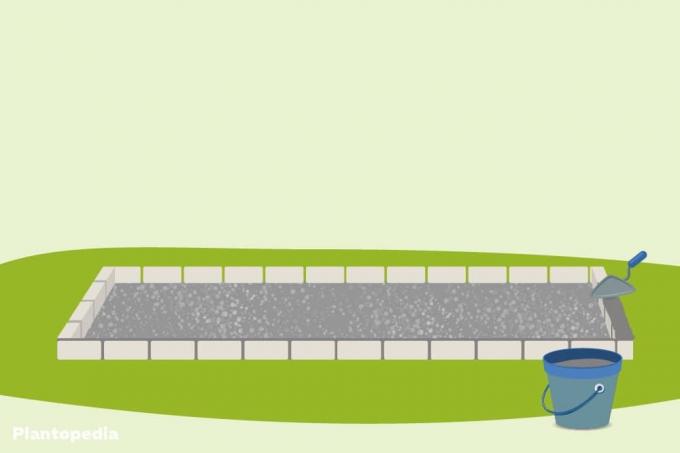
5. Layer stones
When the first shift has been completed, the second follows. When layering the stones, you should now make sure, as with classic masonry, that they are offset. That is, the center of a stone is put on the mortar joint of the lower layer, and so on. Once you have finished setting each stone, use this method to the final height. Give yourself enough time, because this is the only way to make the bed a success.
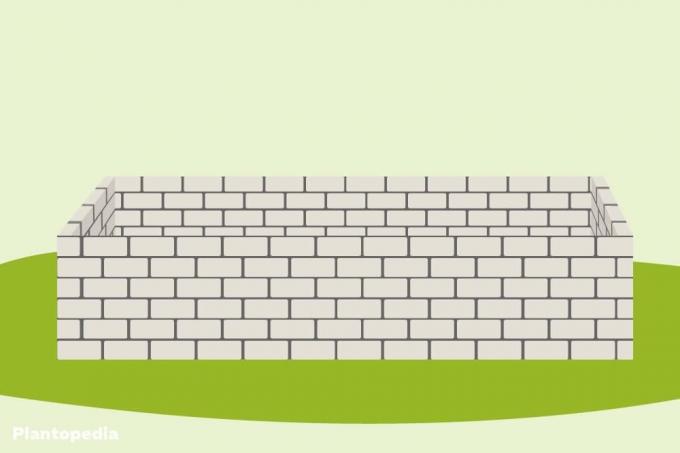
6. Disguise
The raised bed is now ready to be clad. The next important step is the rabbit wire or another wire mesh that is helpful against vermin of all kinds. This is simply placed on the foundation and can be fixed with either mortar or gravel, if you have some left over. At the end, check that the grille is in place.
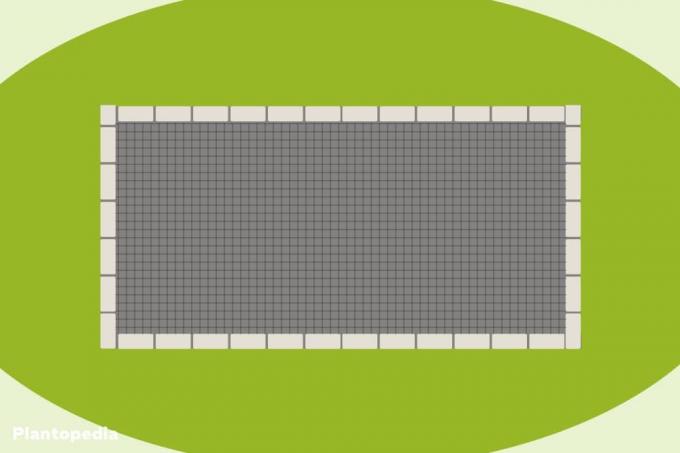
7. Pond liner as moisture protection
Pond liner is the next step in creating your stone raised bed. Cut these to size to cover the inside, which is then protected against moisture penetration. This is particularly important for the mortar and the more sensitive types of stone such as brick or sandstone. To fix it, the film is put over the edge and then fixed with a layer of mortar and other stones. Alternatively, you can think of more decorative types such as wooden strips or small flower boxes that you can use to expand the raised bed. Let your creativity run free here.
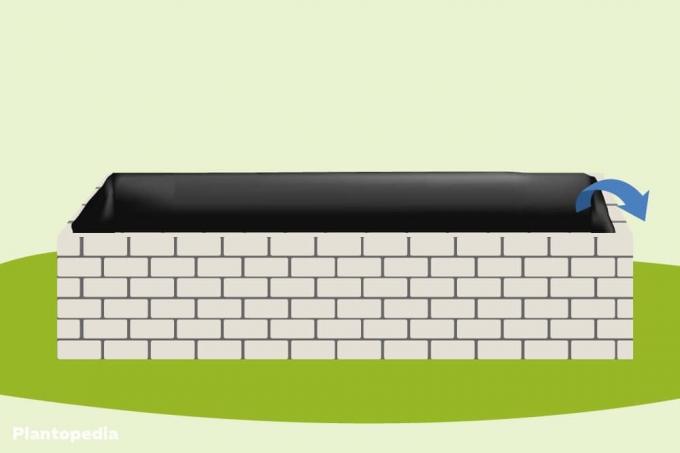
8. Fill the raised bed
Finally, you can start filling the raised bed. Let the mortar dry completely beforehand so that it does not shift and the walls become unstable. If it should rain during the drying time, we recommend a rain protection. Moisture is not necessarily recommended when drying.
In this way, you can create the basic variant of a raised bed that you can wall yourself. You can of course customize your raised bed in terms of design, shape and all other points to suit your taste. The more manual skill or experience you have in this area, the more interesting the results will be.
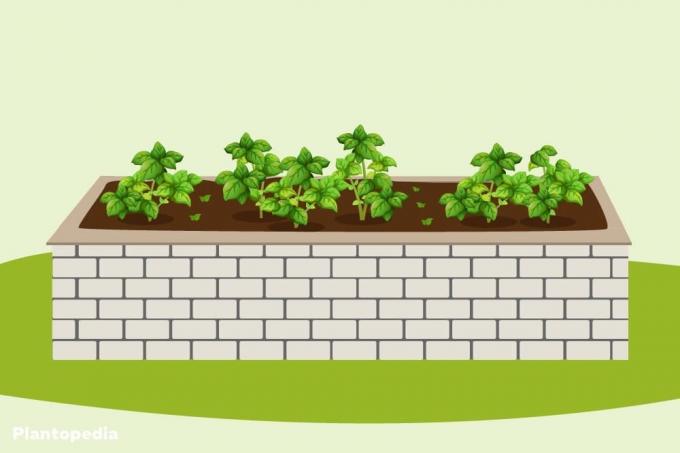
tip: Autumn is recommended as the best time to plant a raised bed filled with compost. By this time, the garden and kitchen waste has sufficiently rotted over the summer and can be used as a nutrient-rich substrate.
